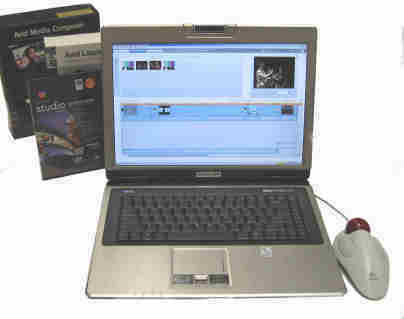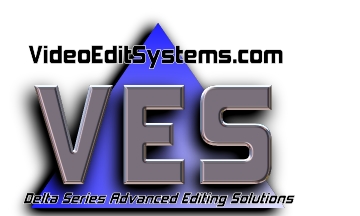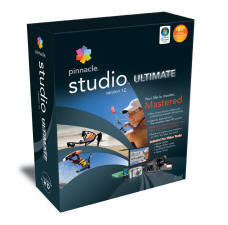To address the issue posed by the title of
this article, what in blazes does a basic video editing software program like
Pinnacle Studio have to do with being on the road to advanced video editing? Has
the author been sipping too much tea made from funny herbs?
Nope. No drugs. Just spending a lot of time in front of the computer screen,
editing. And spending the rest of my time TEACHING film & video production! So
here comes our rationale:
Avid is the software of choice for professional filmmakers and broadcasters
around the world. Yeah, I know, the folks at Apple have spent a ton of money
trying to make us all believe that FCP is Hollywoodís favorite. But the fact is,
Avid accounts for well above 90% of the major market. FCP brags whenever a real
movie or TV show chooses to use it, but Avid (Media Composer) is so entrenched
that they stopped counting screen credits years ago.
Is Avid right for you? Probably not, if you are just getting started. Make no
bones about it, Avid is mighty powerful and versatile, but is very complex to
learn and takes one heck of a computer system to run it. Trust me, we specialize
in building computer systems to run Avid Media Composer.
The good news is that Avid is more than just Media Composer software. It is a
FAMILY of editing solutions, including the renowned Liquid and Pinnacle Studio.
(Pinnacle was acquired by Avid a few years ago.)
That means that a new editor can learn the basics on Pinnacle Studio ($130)
then upgrade easily & economically to Liquid (only $300 to upgrade). Should the
need arise, that editor can also upgrade from Liquid to Media Composer! The
pathway is a natural progression.

Projects originally created in Studio can be imported into Liquid. The
Upgrade package even includes special tutorials to help Studio users make the
upward transition.
As an educator, this pathway from beginner to professional is a valuable
advantage!
Letís take a look at what Pinnacle Studio has to offer.
To begin with, there are a couple of versions of Pinnacle Studio on the
market. Currently, the most advanced package is Studio 12 Ultimate. It sells for
a few dollars more than the non-Ultimate package, but is well worth the
difference in price. Studio 12 Ultimate is packed with way more software tools
than the cheaper package. They even include a green screen drop cloth for doing
your own chromakey effects!
Pinnacle Studio is designed for PC. That can be a real advantage if your
institution is PC based; and more students have access to PCís at home than
Macís. Avid Liquid is also PC based, as is Avid Media Composer. (Media Composer
does offer a Mac version, as well, but the PC version is better if you have a
good computer.)
There are three ways that you can use Studio.
At the simplest level, it offers the choice of using Storyboard type editing.
Real basic drag & drop. Even some software assisted "make a movie for you"
modes. Fine for very young students, or very olde minds, who need to keep things
as easy as possible.
At the middle level, we have a really powerful timeline style of editing.
Around here, we have nicknamed it "Liquid lite", because it borrows so many
advanced features from Liquid.
Studio 12 divides its filmmaking tasks into three stages: capture, edit, and
export (make a movie). Capture is where you would import media from your
camcorder or other source. It can handle pretty much anything out there, from
standard DV to HDV. In addition to capturing taped footage, you can also import
from media on your hard drive, including DVDís, audio CDís, memory cards, and
files. Studio recognizes amateur as well as professional formats. In fact, one
of our network news clients were the ones who turned us on to Studio, because
they use it as an easy way to cut ACVHD and output it to HD for broadcast!
The edit mode allows you to construct a timeline in the conventional,
professional video editing manner. They call the "bins" albums, but you can
access any file in your computer. Mixed scenes (raw footage consisting of
multiple start/stops) can be "scene detected" to break them down into individual
shots. Ditto, individual shots can be re-combined into one master if that is
what you prefer.
Shots can be trimmed to length either on the timeline or in a clip editor.
Shots can be split into two with a razor tool.
A second video track on the timeline allows for A-B roll editing (such as
insert shots, J-cuts, L-cuts); or the track can be used for overlays such as
chromakey, or picture-in-picture.
Studio 12 Ultimate includes a zillion transitions and effects, both 2D and
3D. Just drag an effect over the shot. Effects can also be applied to audio
only, or to titles/overlays. Effects can be edited/controlled by advanced users,
including keyframe mapping of where and how the effect plays on screen.
Full screen preview is just a mouse click away.
The title generator in Studio is modeled after the Title Deko Pro that is
used by Liquid and Avid Media Composer. It is way powerful, and can be combined
with any effect/transition to achieve some mind blowing results. Boris Graffiti
is included with Ultimate, so you lots of graphic tools at your disposal. Or,
just use the presets and ready-made sample templates if you want to keep your
titles simple to use, but professional to view!
There is a frame grabber for freeze frames. Photo import, with color
corrections and pan /scan.
There are some great templates for photo/video montages, including
multi-screen and lots of overlays.
Audio? Besides the camera audio tracks that import with video onto the
timeline, you can add additional soundtracks. Audio can be locked or unlocked to
picture, thus allowing fast & easy L-cuts or J-cuts (having picture without
audio or audio without picture introduce the incoming scene). Voiceover
recording is as simple as hooking up a mic to the computer, and even features a
countdown cue light. A sound effects library is included. Also a music
generating program (akin to SmartSound). A virtual mixing board allows you to
adjust audio levels and panning during playback. You can even create a 5.1
surround track.
For the more proficient user, there are numerous audio tools at your disposal
for noise reduction, special effects, and other audio manipulations.
Need to create a DVD? It is scaringly simple in Studio. Just drop a DVD
template at the beginning of the timeline. Drop each "button" to the point on
the timeline where you want it to play from. Thatís it; go and preview the
virtual DVD in the player. If you are satisfied, just go ahead and burn the
physical DVD (or an ISO image). Editing tools let you customize the look of the
menu and buttons.
Exporting your finished project is simple. Select a format that you want, and
tell it to go ahead. You can export to just about anything out there, from
YouTube, flash, AVI, MOV, and so on. You can play out to tape, or firewire, or
to a file. Audio can be exported to create a soundtrack CD, or just a WAV or MP3
audio file.
"Power User" editing: going beyond the basics covered in the manual.
Remember that I mentioned that there were three levels of Studio? So far, I
have only discussed what is in the manual. But being an experienced editor, I am
familiar with techniques not mentioned for Studio, but are commonly used in
other programs. Such as "fusing" or layering. And multi-camera
editing.
Fusing is where we take a sequence in the timeline and render it out as a
whole file, complete with FX. To do this in Studio, I would copy the project and
re-open the copy version. Erase any of the timeline that we did not want to
render down or fuse. It is a copy, so you are not destroying anything! Then
export the timeline to a video file such as AVI.
Back in the original timeline (or another copy if you really want to protect
yourself against mistakes), browse in the albums (bins) to your newly created
AVI video file and drag it to the timeline or overlay track where you want to
position it. Now, that composite piece of rendered video appears as a single
shot, and you can add another layer of effects over that!
Ditto, we can layer complex amounts of audio in that same manner, so that you
are not limited by the physical amount of soundtracks.
There are lots more advanced tricks one can do in Studio, once one is
familiar with the basic operations. Color correction and audio correction can be
as advanced as you need it to be.
Pinnacle Studio 12 will even do two-camera editing, once you learn to
think outside of the box! You can drop the footage from a multi-camera shoot
onto the video timeline and the overlay timeline, find a common sync point to
align them, and cut (or any transition) between the two cameras. You can even
view both camera streams simultaneously (picture in picture) while you make your
edit decisions! And you can choose either or both audio streams.
(Read our tutorial on two
camera editing.)
What wonít Studio 12 Ultimate do? It does not have SMPTE timecode, nor EDLís.
It does not readily support multi-camera (more than two camera) live editing, nor a multitude of tracks
of video/audio. For that kind of stuff, you need FCP, Premiere, Liquid, or Media
Composer.
However, Studio 12 can be imported into Liquid, so the pathway is easy. Many
of the editing skills and effects are similar in Liquid, which makes it the
ideal upgrade.
I run a copy of Studio 12 Ultimate on the same laptop as my copy of Liquid.
That way, I can use, demo, or teach either program.



